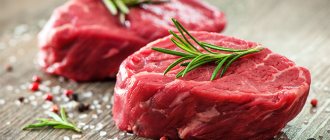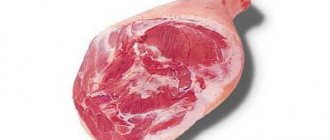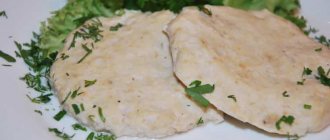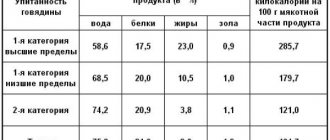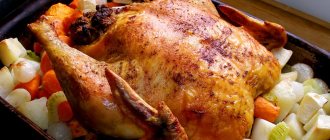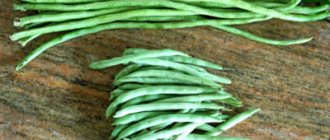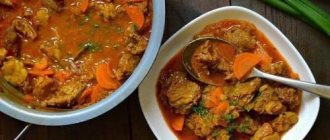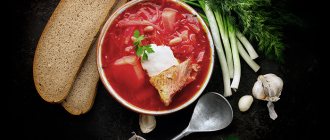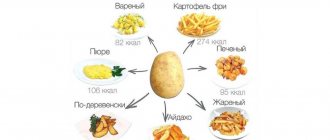Beef is one of the most common types of meat. In cooking, different parts of the carcasses of bulls, cows and calves are equally valued (the flat part of the brisket, the upper part of the shoulder, the middle part of the rump, the rib, neck, sirloin, shoulder, hip or shoulder parts). To prepare main courses, soups, and minced meat, tenderloin, shoulder, flank, front and back shanks are used.
Sausage and cutlet meat usually consists of two types: beef and pork. For steaks, the marbled variety with small layers of fat is preferred, which makes the meat juicy and tender (for example, for T-bone steak), or false fillet. It is cooked steamed, grilled, in the oven, baked in foil and in whole pieces. But what are the calorie content, composition, benefits and harms of this product?
Raw beef calories
What is the energy value of raw beef? Per 100g of lean pulp there are 187 kcal. The nutritional value of the product is represented by the following figures:
- proteins - 18.9 g;
- fats - 12.4 g;
- carbohydrates - 0 gr.
If for some categories (varietal, sirloin and rump) these indicators are the norm, then in the fatty variety, which is usually removed from the lower outer part of the thigh, the calorie content can reach up to 230 kcal. There are also a lot of layers in the flank. The prime cut from the back, the point of the shoulder and the inside of the shoulder are the leanest parts.
If earlier cutlets were prepared from homemade minced meat, now they usually take purchased ones (for example, from Miratorg). Its calorie content should be looked at on the packaging.
Calorie content of boiled beef
When planning the menu for the day, many include boiled meat rather than fried thick sirloin. But how many calories are in boiled beef?
Photo source: shutterstock.com
100 grams contain 232.4 kcalories, and BZHU has the following indicators:
- proteins - 24.3 g;
- fats - 15 g;
- carbohydrates - 0.22 gr.
But the figures given are valid for lean meat. If it has layers of fat, which sometimes occurs, or is smoked and boiled, then the energy and nutritional value will be higher.
How to choose beef
To choose good beef, first of all, you need to pay attention to the storage conditions of the meat and sanitary standards: the butcher must wear gloves, and the meat should not lie on dirty cardboard boxes. The storage area must be clean.
The following factors are relevant:
- Aroma.
Meat with a pleasant milky smell is truly fresh. If the aroma is even a little unpleasant, you can safely pass by. - Color.
Depends on the age of the animal, fattening and breed. If bloody streaks and bruises are visible on the meat, then it is better not to buy it, since they are formed from improper slaughter or illness of the animal. - Darkened and weathered meat.
It is also not recommended to take it.
You need to press on the fiber of the meat: if the dent from your finger quickly smoothes out, then the meat is good. Watery and soft fiber indicates repeated freezing and thawing. A large amount of dense, thick and yellow fat, more like lard, indicates the advanced age of the animal. The fat of a young individual is usually white, with a creamy tint and as if airy.
Calorie content of beef stew
An even lower calorie dish is beef stew, which goes well with steamed vegetables.
Photo source: shutterstock.com
How many calories are in 1 serving of this dish? Per hundred grams comes out to 220 kcal. In this case, the BZHU is represented by the following ratio:
- proteins - 18.3 g;
- fats - 13 g;
- carbohydrates - 0.07 g.
This stewed variety is ideal for a diet.
Calorie content of lean beef
Parts of carcasses that are sold in pieces without layers of fat are considered lean. At its core, it is a fillet that is recommended to be cooked without the use of oil. The product is considered dietary and even after cooking is able to retain most of its beneficial properties.
Photo source: shutterstock.com
So how many calories are in lean beef? 100 grams of this product contain only 158 kilocalories, and BJU is considered ideal for weight loss. This is 7.1 g of fat and 22.2 g of protein. There are no carbohydrates here at all.
Benefits of Beef, shoulder on the bone
You can see a complete guide to the healthiest foods in the “My Healthy Diet” app.
Source
Nutritional value and chemical composition of "Beef, back (thick edge)."
| Nutrient | Quantity | Norm** | % of the norm in 100 g | % of the norm in 100 kcal | 100% normal |
| Calorie content | 108 kcal | 1684 kcal | 6.4% | 5.9% | 1559 g |
| Squirrels | 20.5 g | 76 g | 27% | 25% | 371 g |
| Fats | 2.9 g | 56 g | 5.2% | 4.8% | 1931 |
| Water | 75.5 g | 2273 g | 3.3% | 3.1% | 3011 g |
| Ash | 1.1 g | ||||
| Vitamins | |||||
| Vitamin B1, thiamine | 0.08 mg | 1.5 mg | 5.3% | 4.9% | 1875 |
| Vitamin B2, riboflavin | 0.18 mg | 1.8 mg | 10% | 9.3% | 1000 g |
| Vitamin B4, choline | 70 mg | 500 mg | 14% | 13% | 714 g |
| Vitamin B5, pantothenic | 0.6 mg | 5 mg | 12% | 11.1% | 833 g |
| Vitamin B6, pyridoxine | 0.42 mg | 2 mg | 21% | 19.4% | 476 g |
| Vitamin B9, folates | 9.6 mcg | 400 mcg | 2.4% | 2.2% | 4167 g |
| Vitamin B12, cobalamin | 3 mcg | 3 mcg | 100% | 92.6% | 100 g |
| Vitamin E, alpha tocopherol, TE | 0.57 mg | 15 mg | 3.8% | 3.5% | 2632 g |
| Vitamin H, biotin | 3.5 mcg | 50 mcg | 7% | 6.5% | 1429 g |
| Vitamin RR, NE | 5.26 mg | 20 mg | 26.3% | 24.4% | 380 g |
| Macronutrients | |||||
| Potassium, K | 300 mg | 2500 mg | 12% | 11.1% | 833 g |
| Calcium, Ca | 8 mg | 1000 mg | 0.8% | 0.7% | 12500 g |
| Magnesium, Mg | 26 mg | 400 mg | 6.5% | 6% | 1538 g |
| Sodium, Na | 59 mg | 1300 mg | 4.5% | 4.2% | 2203 g |
| Sera, S | 230 mg | 1000 mg | 23% | 21.3% | 435 g |
| Phosphorus, P | 204 mg | 800 mg | 25.5% | 23.6% | 392 g |
| Chlorine, Cl | 59 mg | 2300 mg | 2.6% | 2.4% | 3898 g |
| Microelements | |||||
| Iron, Fe | 2 mg | 18 mg | 11.1% | 10.3% | 900 g |
| Yod, I | 7.2 mcg | 150 mcg | 4.8% | 4.4% | 2083 g |
| Cobalt, Co | 7 mcg | 10 mcg | 70% | 64.8% | 143 g |
| Manganese, Mn | 0.035 mg | 2 mg | 1.8% | 1.7% | 5714 g |
| Copper, Cu | 182 mcg | 1000 mcg | 18.2% | 16.9% | 549 g |
| Molybdenum, Mo | 11.6 mcg | 70 mcg | 16.6% | 15.4% | 603 g |
| Nickel, Ni | 8.6 mcg | ||||
| Fluorine, F | 63 mcg | 4000 mcg | 1.6% | 1.5% | 6349 g |
| Chromium, Cr | 8.2 mcg | 50 mcg | 16.4% | 15.2% | 610 g |
| Zinc, Zn | 3.24 mg | 12 mg | 27% | 25% | 370 g |
The energy value of Beef, back (thick edge) is 108 kcal.
Main source: Skurikhin I.M. and others. Chemical composition of food products. Read more.
** This table shows the average levels of vitamins and minerals for an adult. If you want to know the norms taking into account your gender, age and other factors, then use the “My Healthy Diet” application.
Composition and nutritional value of beef
What is the main advantage and biological value of this type of meat? This variety has a balanced chemical composition. Thanks to it, beef meat products provide quick satiety. What substances are included in the chemical composition of this type of meat?
Photo source: shutterstock.com
It is represented by the following substances:
- iron;
- zinc;
- B vitamins;
- calcium;
- potassium;
- vitamin E;
- magnesium;
- fluorine;
- manganese;
- molybdenum;
- phosphorus.
Also, the rich mineral and vitamin complex contains copper, vitamin PP and other substances beneficial to the body of an adult and a child. At the same time, beef meat does not provoke allergies. That is why it is often introduced into baby food.
Daily intake of beef
What piece can you eat a day so that it is healthy and does not harm the body? The daily intake is 150 grams for an adult.
Photo source: shutterstock.com
For children, this figure is less and is only 80 grams. However, doctors strictly do not recommend including beef in your daily diet. But you should not use it more than 3-4 times a week.
The benefits and harms of beef
What are the beneficial properties of the product? How is it good for the body of a man, woman or child? The benefit of beef lies in its high protein content. Due to this, it is able to satiate a person as quickly as possible without harming the figure. At the same time, the meat contains very little fat, which reduces the load on the kidneys, heart, liver and blood vessels.
Photo source: shutterstock.com
Beef can be safely included in the diet during weight loss and for pregnant women. The amino acid composition of the product is absolutely safe. There are other positive properties of tenderloin, which provide:
- improvement of metabolism;
- removing harmful cholesterol from the blood;
- strengthening the walls of blood vessels;
- increase in muscle mass.
Another product allows you to normalize the functioning of the gastrointestinal tract, effectively restores blood flow, and provides high-quality prevention of anemia. Beef stimulates active brain activity, strengthens hair, bones, nails and teeth, and normalizes the functioning of the central nervous system.
It is recommended to include beef in the menu of people who actively train or whose work involves heavy daily loads. It will prevent the body from becoming exhausted. It is also worth introducing it during the recovery process after injuries, operations, loss of large amounts of blood and serious illnesses.
Photo source: shutterstock.com
But beef is not always healthy for everyone. For some, it can only bring harm. It is important to consume meat in moderation, otherwise excessive intake of protein into the body can impair the optimal functioning of the stomach, liver and kidneys. You may also encounter other problems:
- formation of stones;
- decreased immunity;
- increased risk of esophageal cancer;
- failure in the functioning of the myocardium;
- inflammation of the pancreas, kidneys and other organs.
Also, excessive consumption of meat can provoke the formation of cholesterol plaques, which lead to blockage of blood vessels.
ABC RECOMMENDS
Fried potatoes: calorie content, benefits, nutritional value
Recipe for boiled beef in a slow cooker
The selected type of meat has relatively high fiber stiffness; it takes longer to cook than pork or chicken. Moderate fat content and a special protein composition compensate for this inconvenience when it comes to a balanced diet. A multicooker makes cooking boiled beef somewhat easier.
The device is convenient, has specially designed operating modes, and with the lid tightly closed, the meat cooks a little faster.
Composition of ingredients
What to cook from:
- whole slice beef – up to 1 kg;
- 2 bay leaves;
- 2 carnation umbrellas;
- black pepper – 4 peas;
- water and salt - as needed.
Step-by-step cooking process
How to cook:
- For boiling this method, frozen meat is also suitable; in this case, the beef is allowed to slowly thaw in the general compartment of the refrigerator. To reduce moisture loss, the meat is placed in a bag.
- The slice is washed, cut into large pieces of 200–250 g, placed in a bowl, and filled with clean cold water. The quantity is measured, exactly 2000 ml is needed, or water is poured according to the marks, with the expectation of covering the meat completely.
- The operating mode of the device is “Quenching”, the cycle duration is set to 90 minutes. Cook the beef with the lid lowered and fixed; it is important to remember that the indicated time applies to devices without a pressure cooker function.
- After the timer goes off, add spices and 2-3 tsp to the broth. coarse salt. Stir the broth and activate the previous mode, this time for 30 minutes, and lower the lid.
- If the multicooker automatically switches to heating mode at the end of operation, you must disable this function or monitor the device signals. Allow the beef to cool for about 40 minutes. in hot broth, then remove the bowl, cover it and take it out into the draft.
- Remove the meat from the still warm broth, immediately cut the required amount, put the rest in an airtight container, and put it in the refrigerator. The broth itself can be used immediately or frozen.
What can I add?
Broths for soups are usually cooked with the addition of cartilage, veins, and fatty pieces of pulp. If you plan to use meat broth in dishes that are not included in the diet, such parts can be placed in the slow cooker at the same time as the beef. The calorie content will only increase in the broth; slices of boiled beef will not become fattier.
A good solution is to cook jellied meat this way. In this case, after boiling the beef for 60 minutes, add a chopped pork knuckle, a pair of pork legs, and a slice of meat. Prepare according to the recipe described above, take out the beef, and put whole onions and carrots into the broth, add salt and spices, extend the regime for another 1 hour.
How to serve a dish
When following the prescribed diet, follow its recommendations. If boiled beef is included in the regular menu in order to reduce the calorie content of the diet, it is served with chopped fresh vegetables, salads without oil and mayonnaise.
Use low-fat yogurt as a dressing; carefully monitor the spiciness of sauces and the amount of salt used. Meat salads and light snacks are prepared from boiled beef according to the recipes that will be given below.
Beef calorie table
To make it easier to calculate the energy value of your menu for the day, use the ready-made data presented in the table:
| Name of the dish | Calorie content per 100 g (kcal) |
| Beef broth | 4 |
| Entrecote | 220 |
| Shchi with beef | 42 |
| Beef Stroganoff | 193 |
| Beef pilaf | 219 |
| With onions and other vegetables | 116 |
| Smoked-boiled | 113 |
| Boiled in water without salt | 217 |
| Dried | 235 |
| With gravy | 117 |
| Dry-cured | 272 |
| Baked in the oven | 168 |
This video recipe will help you prepare a dietary beef dish:
Classic recipe
Simply putting meat in boiling water and keeping it in it for the required time will not cook tasty beef.
Even following the strictest calorie diets does not mean that you need to eat something completely tasteless. When boiling, vegetables, aromatic roots, and a limited amount of salt are added to the broth. If the diet is designed to reduce calories and is not prescribed for the purpose of treating diseases of the digestive system, moderate use of spices is acceptable.
Composition of ingredients
What to cook from:
- fresh beef shoulder or hind leg - 1 kg;
- a couple of sweet carrots;
- large parsley root;
- 1/2 small bell pepper;
- a handful of mixed greens - parsley, basil, dill;
- 3 tsp. salt;
- bay leaf;
- 150 g small onions;
- 2-3 peppercorns.
Step-by-step cooking process
How to cook:
- The meat should be boiled in a whole, large piece, without cutting. A pot or saucepan with a massive base is placed on rapid heating, and 3 liters of clean water are heated to a boil.
- The beef is stripped of films, washed and dipped in boiling water, stirred briefly, preventing the flesh from sticking to the bottom or walls. Remove the skins from the onions, scrape and rinse the carrots.
- After removing the foam from the surface of the re-boiled broth, lower the whole vegetables into it. Peel the root and select the seeds from half the pepper, place them in a saucepan, adjust the heat to a barely noticeable boil.
- Cover loosely with a lid and make sure that the boiling has increased slightly, cook the beef for 2 hours. Add spices, herbs and salt to the broth, stir, return the lid to its previous position.
- After 30 min. the finished beef is briefly removed from the pan, the broth is quickly filtered, using a colander with a piece of gauze lined with it. The meat is returned to the broth and the heating is turned off.
- Leave the boiled beef in the broth for a quarter of an hour, loosely covering the pan. Then the lid is moved more tightly, it is advisable to expose the pan to a draft or move it to a cool room until it cools completely.
What can I add?
Boiled beef, the calorie content of which becomes even lower after heat treatment, does not require a large amount of salt and spices. In addition to the parsley root, you should add a slice of celery to the broth; if diet conditions allow, add 1 more bay leaf.
How to serve a dish
The diet broth is too heavy; it is used in other dishes. The beef is flattened into 1cm-thick slices before the meat has cooled completely. It is important not to let the beef dry out; for this reason, cut off exactly as much meat as is required for the table.
Boiled beef, the caloric content of dishes from which must fit within the diet, is served with coarse bread made from second-grade flour, gray or containing bran. It is worth offering salads from fresh vegetables and mild sauces with boiled meat. Mustard is an ideal addition, but its spiciness should also be moderate.
